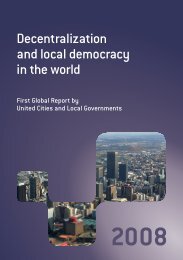Making Cities Resilient Report 2012
Making Cities Resilient Report 2012
Making Cities Resilient Report 2012
You also want an ePaper? Increase the reach of your titles
YUMPU automatically turns print PDFs into web optimized ePapers that Google loves.
Chapter 6.<br />
Conclusions of the report<br />
This report set out to review trends in urban resilience and identify factors that contribute to or enable<br />
progress in reducing risk at the local level. Through analysis of case material provided by cities and<br />
Partners participating in the <strong>Making</strong> <strong>Cities</strong> <strong>Resilient</strong> Campaign, several broad conclusions are evident:<br />
1. Innovation abounds despite variable baseline urban conditions.<br />
2. The <strong>Making</strong> <strong>Cities</strong> <strong>Resilient</strong> Campaign has triggered new momentum.<br />
3. Commitments to date can be strengthened and extended.<br />
1. Innovation abounds in very diverse settings<br />
The city cases reviewed in this report are very diverse with varying levels of socio-economic development,<br />
size and economic bases. <strong>Cities</strong> as apparently different as Pune in India, Kampala in Uganda and San<br />
Francisco in California have demonstrated a common ability to further strengthen their capacities,<br />
commitment and, ultimately, reduce losses – regardless of their baseline conditions.<br />
Moreover, cities reported here include some that had historically given little attention to issues of disaster<br />
risk and resilience and others that have already established a solid foundation for urban resilience. Some<br />
cities such as Siquirres, Beirut and Dubai have taken their first steps through small but focused activities<br />
that initiated more sustained action. <strong>Cities</strong> with more mature mechanisms in place, such as North<br />
Vancouver, Mumbai, Makati and Albay Province, demonstrated more active leadership through revisiting<br />
the impact of their own efforts and sharing insights with others.<br />
“Governments at all levels must focus less<br />
on what is destroyed by natural hazards<br />
and more on what can be improved. The<br />
challenge facing governments is not<br />
always about a lack of money, but about<br />
understanding how you spend the resources<br />
you do have. This is where the Campaign<br />
is playing a critical role now and will<br />
continue to do so in the future. Educating<br />
communities and governments at all<br />
levels about the vulnerabilities linked to<br />
rural-urban migration and the importance<br />
of investing in critical infrastructure,<br />
especially roads, flood defenses and<br />
protecting schools and hospitals, should<br />
be a strong focus for the campaign going<br />
forward.”<br />
Hon. Byarugaba Alex Bakuuda,<br />
Member of Parliament, Uganda.<br />
In small urban centres, activities tend to focus on upgrading<br />
and repeated cleaning of drainage systems to cope with<br />
floods, or putting in place early warning systems to reduce<br />
vulnerability to storms. Here, local governments often rely<br />
on community participation, as well as input from NGOs<br />
and local universities. In large cities, disaster risk reduction<br />
is more complex. It requires an institutional process that<br />
encompasses strategic planning, assigned budgets, and a<br />
more sophisticated understanding of multi-hazard risk and<br />
vulnerability and how they are interconnected.<br />
In describing the broad range of activities that they have<br />
undertaken, cities have been able to identify enabling<br />
factors contribute to progress:<br />
• Leadership and political will<br />
• Sustainability at local level<br />
• Engagement in high impact activities early on<br />
• City-to-city learning and international support<br />
• Integrating disaster risk reduction as a cross-scale<br />
and multi-sector issue<br />
• Addressing existing infrastructure deficits<br />
Yet, beyond these features, cities remain as centres of<br />
culture and innovation. The innovative spirit of the local<br />
governments participating in the Campaign is evident<br />
across the board.<br />
76 | <strong>Making</strong> <strong>Cities</strong> <strong>Resilient</strong> <strong>Report</strong> <strong>2012</strong>

















